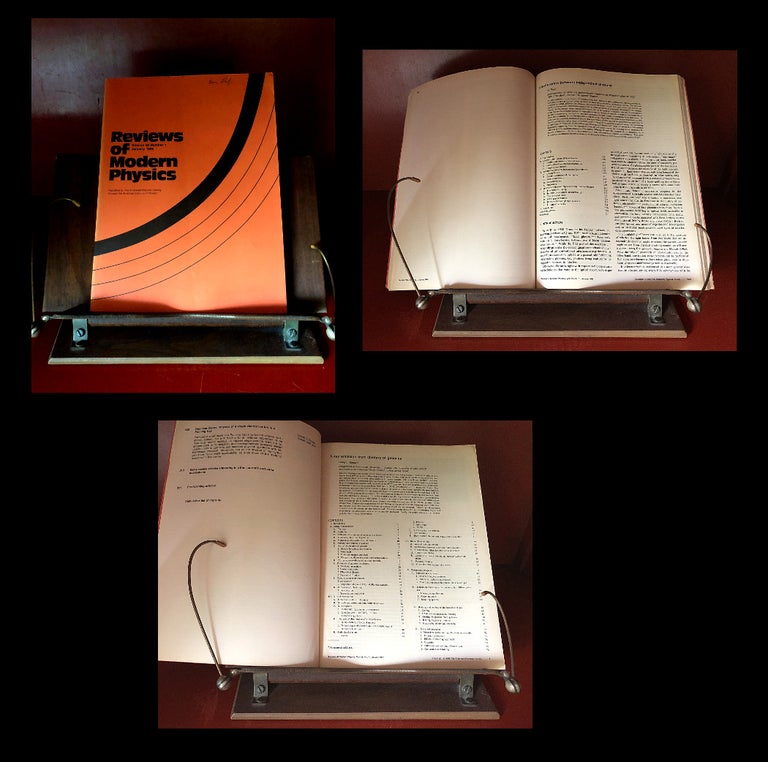Interference between independent photons (Paul, pp. 209-233) WITH X-ray emission from clusters of galaxies (Sarazin, pp. 1-117) WITH in Reviews of Modern Physics, Vol. 58, Number 1, January 1986
Lancaster: American Physical Society, 1986. 1st Edition. FIRST EDITION IN ORIGINAL PRINTED PAPER WRAPS OF TWO EXTENSIVE & WELL-REGARDED SURVEY PAPERS: the first, the German physicist H. Paul’s comprehensive review of investigations, both theoretical and experimental, demonstrating photon interference even when the fields involved are produced by independent sources; the second, the American astronomer Craig Sarazin’s important review on the interaction between gas and galaxies in clusters.
PAUL’S PAPER demonstrates that “experiments with two independent light sources have shown that a photon from one source can interfere with a photon from the other source" and that “problems appear with Dirac’s dictum interference effects produced by light beams from two completely independent sources” are taken into account (Honig, Quantum Uncertainties, 340; (Progress in Optics, Vol. 36, 67). More specifically, Paul’s work makes clear that “for two-slit systems that use two independent laser sources with brief (<1 ms) intervals of mutual, each photon has been considered to arise from both beams and has a probability amplitude to pass through each of the two slits. (Alkon, "Either-or two-slit interference, Biophys J., May 2001, 2056).
Paul writes: “The physical situation is… different for coherent and incoherent fields. In the first case, where the sources are lasers, a conventional interference pattern can be observed which is adequately described by the classical theory…Special attention is paid to the question of whether this interference persists when the two laser beams become strongly attenuated. In the second case, the sources are individual atoms excited by a pumping mechanism, that emit spontaneously and, hence, independently from each other. In those circumstances, no interference pattern can show up. However, it becomes evident from both the classical and the quantum-mechanical theory that interference effects can still be established by observing intensity correlations rather than the intensity itself. The pioneering experiments of Forrester, Gudmundson and Johnson, and Brown and Twiss are reviewed in this context. Especially interesting from the theoretical point of view is the case of two emitting atoms, since then the classical and the quantum-mechanical description differ significantly, the quantum theory predicting the intensity correlations to be distinctly stronger than those following from classical considerations. This specific quantum-mechanical feature is shown to be intimately connected with the corpuscular aspect of light” (Paul, 1986, p. 209).
SARAZIN’S PAPER is “a comprehensive survey of the hot gas pervading clusters of galaxies, a strong source of cosmic x-rays” (New Scientist 22 April 1989, 74). Both highly-regarded and exhaustive, Sarazin demonstrates that there is much independent X-ray evidence that cooling flows exist. “In this paper the x-ray observations of clusters of galaxies are reviewed. Related optical and radio measurements of clusters are also summarized. Theories for the physical state, distribution, origin, and evolution of the intracluster medium are extensively discussed” (Sarazin, 1986, p. 1).
ALSO INCLUDED: Brown & Gabrielse “Geonium Theory: Physics of an Electron or Ion in a Penning Trap” (pp. 233-313) WITH R. B. White’s “Resistive Reconnection” (pp. 183-209). Item #1064
CONDITION & DETAILS: Lancaster: American Physical Society. Original printed wraps. (10.5 x 8 inches; 263 x 200mm). This is not an ex-institutional copy. Single ownership signature of Boris Leaf, the Japanese-American physicist with achievements including research in statistical mechanics, thermodynamics and quantum mechanics. Very slight fading at the spine. Bright and clean. Near fine.
Price: $135.00

